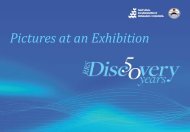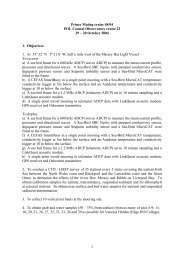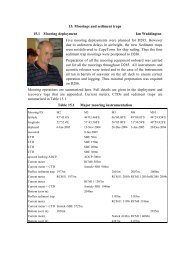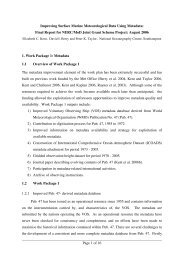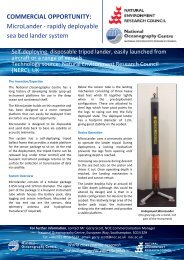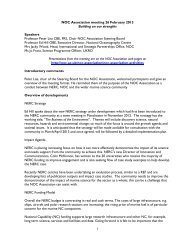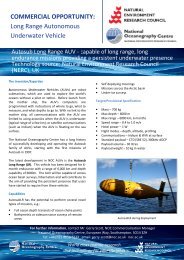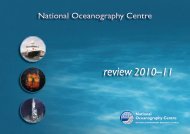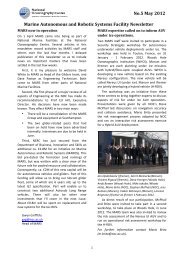Newsletter 8 - April 2013 - National Oceanography Centre
Newsletter 8 - April 2013 - National Oceanography Centre
Newsletter 8 - April 2013 - National Oceanography Centre
You also want an ePaper? Increase the reach of your titles
YUMPU automatically turns print PDFs into web optimized ePapers that Google loves.
No. 8 March <strong>2013</strong>Autosub Long Range Trials atPLOCAN in Gran CanariaFrom January 20 th to March 15 th we carriedout a series of trials of the Autosub LongRange AUV, with a base at the SpanishOceanographic research institute PLOCAN(Platform Oceanic of the Canary Isles). Thesite was chosen because of the access to deepwater, the support offered by ourcollaborators at PLOCAN, and the relativelybenign weather conditions anticipated.The trials were a success, with much learntabout the characteristics of the vehicle,several problems identified and solved, and agreat deal of experience gained in operatingthe vehicle in a range of environments fromnear shore to depths over 1000 m.Perhaps the greatest achievement was ademonstration that such trials of an AUVcould be accomplished from a shore base. TheAUV was deployed from a trailer on a ramp,The initial tests concentrated in the bay areasouth of PLOCAN, and later extending out to13 km offshore, as the AUV ran down theslope and back.Miles Pebody helping to launch the Autosub LongRange AUV at Taliarte, Gran Canariafrom where a small rib towed it a shortdistance to just outside the harbour atTaliarte.The Position of Taliarte and PLOCAN in Gran Canaria,and the track westwards which the Autosub Long RangeAUV followed as it tracked downslope.Descent of Autosub Long Range East of Taliarte , GranCanaria to 1050m depth. The descent was not withoutproblems: strong upwelling due to a seamount on theslope caused the AUV to rise above ADCP bottom trackingrange for part of the descent.We sent a signal to the AUV over a WiFicommunications link, and the AUV began itsjourney east , along the short shelf edge outof Melanara bay, following the slope at analtitude of 60 m down to a depth of 1050m.Then the AUV turned and headed back at analtitude of 90m, finally stopping on thesurface a few tens of metres away from theharbour entrance, from where it was towedback by the RIB to the trailer ramp.All this was accomplished without steppingfoot on a boat. All the command and controlwas accomplished from the PLOCAN shorefacilities, over WiFi and Iridium satellite datalinks.3
No. 8 March <strong>2013</strong>An example of the support that Aida and herprofessional diver colleagues at ECOS Canaria were ableto offer us, particularly in the early period of the trialswhen we had some teething problems.We are very grateful for the assistance of theCarlos Barrera and his team at PLOCAN, andalso to Aida, July, Miguel, Bachi, and Gregorio,crew of the dive boat Lion, with ECOSCanarias, who helped us with our handling ofthe AUV at sea, and rescued it from 5 kmoffshore at night, when things didn’t quite goto plan.Stephen McPhailSeagliders: no newsNot an inspiring news item but one thatanswers a frequently asked question. iRobotare still in discussion with several possibleSeaglider producers but, at this stage, thereare no plans to resume production this year.Although not selling whole gliders, they arestill offering support to users throughmaritimesupport@irobot.com, even thoughsome of the names and faces we know fromrecent years are no longer there. They arealso still selling spares and replacement itemsoff-the-shelf. And iRobot are still running pilotand refurbishment training courses; JamesBurris and Sam Ward from MARS (picturedhere) undertook both courses at the end of2012.From left to right: Erik M Bruvik, Tore De Lange,(University of Bergen), Rosario Robert, CoreyMacdonald, Andrew Woogen, Robert Hughes (iRobot)Sam Ward, James Burris (NOC) on the refurbishmentcourse in December 2012BODC to host UK ocean gliderworkshopThe British Oceanographic Data centre (BODC)at the Proudman building in Liverpool ishosting a one day workshop on the 18 th of<strong>April</strong>. Topics for discussion will include:Current science and researchinvolving gliders in the UK,Technology developments, newsensors, results of sensor evaluations,Assessments of glider technology formonitoring purposes,Developments in glider datamanagement (GROOM/EGO formats,GDACs, GTS submission, linkage withNOAA and IMOS etc),Developments in glider dataprocessing .Aimed at the UK science community, theyespecially welcome people and groups thatare new to the ocean glider community,whether to contribute, to learn or just tocome and talk with other glider users. Anyonewho hasn’t been notified and would like toattend, please contact Justin Buck atjuck@bodc.ac.uk4
No. 8 March <strong>2013</strong>Sensors in Gliders (SAUG): First seatrialsMARS seaglider SG550 Eltanin ventured northto Scotland once more, for test flights withthe new NOCS fast CT sensor and nutrientsensor. After some tricky ballasting inSouthampton, the aim was to get the glider tofly in a straight line with a 4kg lump ofnutrient sensor in her tail, and an extra CTDon board. The nutrient sensor was a dummypackage in this case, but the CTD was the firstfully working unit.OSMOSIS continuesThe two Seagliders at the OSMOSIS site on thePorcupine Abyssal plain (PAP) that weredeployed back in September, Caltech’s SG566Orca and MARS’s SG533 Canopus wererecovered by a UEA and MARS team inJanuary, on the RV Celtic Explorer. They werereplaced by the two UEA gliders, SG502 Minkeand SG579 Humpback, which in turn areplanned to be replaced in <strong>April</strong> from theJames Cook. So far the site has beencontinuously occupied by gliders since July2012, for more details see the UEA web site athttp://ueaglider.uea.ac.uk/DIVES/ .AUVs and gliders at Ocean Businesson board the Seol MaraEltaninThe results of the flight trials were gratifyinglysuccessful, and once the nutrient sensor isfully installed into Eltanin and SG534Denebola, later this year, the second phase ofdeep water trials will take place.Autonomous Surface Vehiclecontracts awardedThe second phase of the Long EnduranceMarine Unmanned Surface Vehicles project(LEMUSV) has awarded contracts to fiveapplicants to develop their prototype vehicles.The tendering process is coordinated by MARSon behalf of NERC and TSB (the TechnologyStrategy Board), as reported in the last MARSnewsletter. The successful companies are ASVLtd, Blue Bear Ltd, Intrepid Minds Ltd, MOSTLtd and the University of Aberystwyth. Formore information on the competition contactRolly Rogers on rxr@noc.ac.uk or 02380596134Ocean Business is hosted at NOCS between 9 thand 11 th <strong>April</strong> <strong>2013</strong>. One of the Big Two in UKoceanographic shows, there is a lot of AUVand glider specific material and numerousexhibitors, with a host of talks,demonstrations and presentations that willinterest those of us operating and developingthese vehicles. There are AUV and gliderpresentations from Teledyne Webb, Hydroid,Liquid Robotics, Bluefin, Kongsberg andExocetus among others. There is anAutonomous Systems workshop on theWednesday under the chairmanship of PatrickCarnie of the UK Marine Alliance, andpresentations on all three days by sensormanufacturers including Wet Labs, Seabird,Teledyne, Chelsea and Nortek aimedspecifically at gliders and AUVs with manymore non-AUV specific sensor manufacturers,too numerous to mention, for those thinkingoutside the box. Full details, programme andfree registration can be found at theexhibition web site athttp://www.oceanbusiness.com/5
No. 8 March <strong>2013</strong>BAS gliders in the AntarcticSwallow at the deployment site in Marguerite bay (photo courtesy of Ben Allsup)In December 2012, two BAS-owned deepSlocum gliders (“Swallow” and “Amazon”)were taken to Rothera, Antarctic Peninsula,for their first full deployments. They arrivedby ship just before Christmas, along with theglider team of Hugh Venables and MikeMeredith (BAS), David White (MARS, NOC)and Ben Allsup (Teledyne Webb Research).A particular aim of the fieldwork was toaugment the time series measurementsundertaken close to Rothera as part of theongoing BAS time series monitoringprogramme. This programme (“RaTS”, theRothera Time Series) has been conductedsince 1997, and has excellent temporalresolution and span. However, common to allocean time series, the spatial context andrepresentativeness of the data is less wellconstrained, so comparable spatialmeasurements are also required. The sensorson the gliders were the same as those on theCTD used for RaTS (CTD, PAR andfluorescence) and also turbidity.Following a series of short test deploymentsclose to the base at Rothera, the two gliderswere deployed on longer (multi-week)missions across the broader Peninsula shelf.This data will be used to investigate thephysical processes responsible fordetermining the changing oceanographic andbiogeochemical properties observed at RaTS,including upwelling, mixing, advection bycoastal currents, and submesoscale variability.Perhaps the most interesting discovery was,however, a depression on the shelf with waterproperties very different from those thattypify the western Antarctic Peninsula.Whereas the deeper layers of the westernPeninsula are typically bathed by warmCircumpolar Deep Water (CDW) from theAntarctic Circumpolar Current, one of ourgliders penetrated a depression that wastopographically isolated from the CDW inflow,thus showed much colder water temperatures(below zero at 500m, compared with over 1°Cat the same depth in at the RaTS site, forexample). The mechanisms by which thisanomalous water forms, and its implications6
No. 8 March <strong>2013</strong>for the resident marine biota, will beaddressed using the data collected.In many respects, Rothera is an ideal locationfor a glider base. There are five small boats,used for water sampling and diving, and thesealso work very well for glider deployment andrecovery. The Bonner Laboratory at Rothera isa good facility for glider preparations andoffice space. The water is also deep very closeto the coast, with 300m of water depth withinhalf a mile of the wharf.Working in such a remote and hostileenvironment has its drawbacks also, however,and these included slow internet speeds, andthe physical hazards presented by icebergs.Ice reconnaissance helped alleviate the icerisk to some extent, with satellite images fromPolarview (www.polarview.aq) being providedon a regular basis, and photographic/visualreconnaissance from the BAS Air Unit beingconducted during scheduled flights into/outof Rothera. Despite this, one glider didbecome trapped beneath an iceberg for a day,though it got free and continued its mission.We will be working with the manufacturers tofurther improve ice avoidance software andhardware for future seasons.The southern end of Adelaide island showing the tracksof both gliders prior to recoveryBoth Swallow and Amazon are now back atRothera after an eventful but ultimately verysuccessful season. The data from these, andthe two similar American gliders operatingfurther offshore at the Peninsula, will leadtosome interesting and important newinsights into this rapidly-changing part of theocean.Hugh Venables, Mike Meredith, Paul Anker(BAS), David White (NOC), Ben Allsup (TWR)And finally: what’s in a name?Some folk call their gliders by their names, others stick to the manufacturer’s numbering. In MARSwe tend to use both, as seems most appropriate at the time, but with an influx of new Slocums wewill have to come up with some new names if we are to continue the tradition. The deep Slocums atSouthampton, also known affectionately (or otherwise) as the Fossil gliders, have all ended in “-ite”,starting alphabetically with Ammonite, Bellamite and Coprolite. The fossil requirement wasrelaxedlater, although even that did become a contentious issue. The fourth Slocum glider had to berenamed “Dolomite” to ease her transit through customs and police checks. Even non-Englishspeakers will look at a yellow torpedo called “Dynamite” with some trepidation. A committeeconvened in a pub in Oban this month and commented favourably on “Marmite” for the newestaddition, but the chairman (me) welcomes any further suggestions, frivolous or serious, on apostcard.David White7
Details and Contacts for the Autonomous Vehicles based at NOC8No. 8 March <strong>2013</strong>Autosub3 This vehicle is a large general-purpose, propeller-driven AUV with a 1600m diving depth and arange of ca. 300km depending on payload. It comes with an EM2000 swath bathymetry sonar, CTDs andADCPs. Programming and technical contact: Steve McPhail (sdm@noc.ac.uk)Autosub6000 This vehicle has a diving depth of 6000m, comes equipped with an EM2000 swath sonar, adual frequency 120/410kHz Edgetech sidescan sonar and a chirp sub-bottom profiler, as well as CTDs and anADCP. Programming and Technical contact: Steve McPhail (sdm@noc.ac.uk).Autosub Long Range Autosub Long Range (ALR) is in final engineering development; science use will beginin <strong>2013</strong>. Combining a depth capability of 6000m with an ultimate range of 6000km it can carry low powersensors; as standard it has a CTD and ADCP. Programming and Technical contact: Steve McPhail(sdm@noc.ac.uk).Teledyne Webb Research 1000m Slocum gliders – Ammonite, Bellamite, Coprolite, DolomiteThese gliders are all to G2 specification and carry an unpumped Seabird CTD, Anderaa oxygen optode andWetlabs triplet sensor for CDOM, Chl-a and turbidity. They have a proven endurance of at least 86 days usingprimary lithium batteries. Contact: David White (dwh@noc.ac.uk)Teledyne Webb Research 200m Slocum gliders These are also all G2 gliders.Unit 117 (Zephyr) and Unit 345: Both carry an unpumped Seabird CTD, an Aanderaa oxygen optode, and aWetlabs triplet sensor for CDOM, Chl-a and turbidity.Unit 175 (Rooney): Also has an unpumped Seabird CTD, as well as a Rockland Scientific MicroRiderturbulence probe (microconductivity, shear and temperature at up to 512Hz).Unit 194: This has a pumped Seabird CTD, an Aanderaa oxygen optode, a Wetlabs triplet sensor for CDOM,Chl-a and turbidity.For all Slocum gliders contact: David White (dwh@noc.ac.uk), but note that potential users of the turbulenceglider Rooney should also contact Dr Matthew Palmer at NOC Liverpool to discuss their requirements(rolm@noc.ac.uk).iRobot 1000m 1kA SeaglidersAll carry an unpumped Seabird CTD, a Wetlabs BBFL2-VMT 650/CDOM/Chl-a puck and an Aanderaa 4330oxygen optode:SG532 Bellatrix: Has a standard fairing and payload bay.SG533 Canopus: Has a standard fairing and payload bay, currently fitted with a PAR sensor.SG534 Denebola: Is primarily for the NERC programme Sensors-on-Gliders programme in <strong>2013</strong> and hasbeen fitted with a larger, ogive fairing to provide additional payload space.SG550 Eltanin: Is primarily for the NERC programme Sensors-on-Gliders programme in <strong>2013</strong> and has beenfitted with a larger, ogive fairing to provide additional payload space.Contact for all Seagliders: David White (dwh@noc.ac.uk)Legal issues and Diplomatic Clearance – These are increasingly important for autonomous vehicles andadvice can be given by Roland Rogers at NOC Southampton, contact: rxr@noc.ac.ukDetails and Contacts for UK Autonomous Vehicles and Gliders other than NOCScottish Marine Institute:SMI has two Seagliders, Talisker and Ardbeg equipped with CTD, dissolved oxygen, optical backscatter andchlorophyll fluorescence sensors. SMI also has a Hydroid REMUS 600 AUV Rebus. It carries a CTD, an ADCP forcurrent profiling and navigation, a fluorometer for chlorophyll estimation and a turbulence sensor suite. Forfurther details contact Prof. Mark Inall at mark.inall@sams.ac.ukBritish Antarctic Survey: BAS has two Teledyne Webb G2 gliders rated to 1000m depth, Swallow andAmazon, contact Dr Mike Meredith: mmm@bas.ac.uk, and a Seaglider with acoustic backscatter sensor,contact Sophie Fielding sof@bas.ac.uk.University of East Anglia has three iRobot Seagliders (SG502 Minke, SG510 Orca, and SG579Humpback). All have CTD, dissolved oxygen using the Aanderaa optode and the optical backscatter andfluorescence sensors. SG510 is now fitted with a Photosynthetically Available Radiation (PAR) sensor. ContactProfessor Karen Heywood at K.Heywood@uea.ac.ukHeriot-Watt University has a Hydroid REMUS100 AUV and Nessie, a hover capable AUV built at theuniversity (see http://auvac.org/configurations/view/42). Contact Professor Yvan PetillotY.R.Petillot@hw.ac.uk




